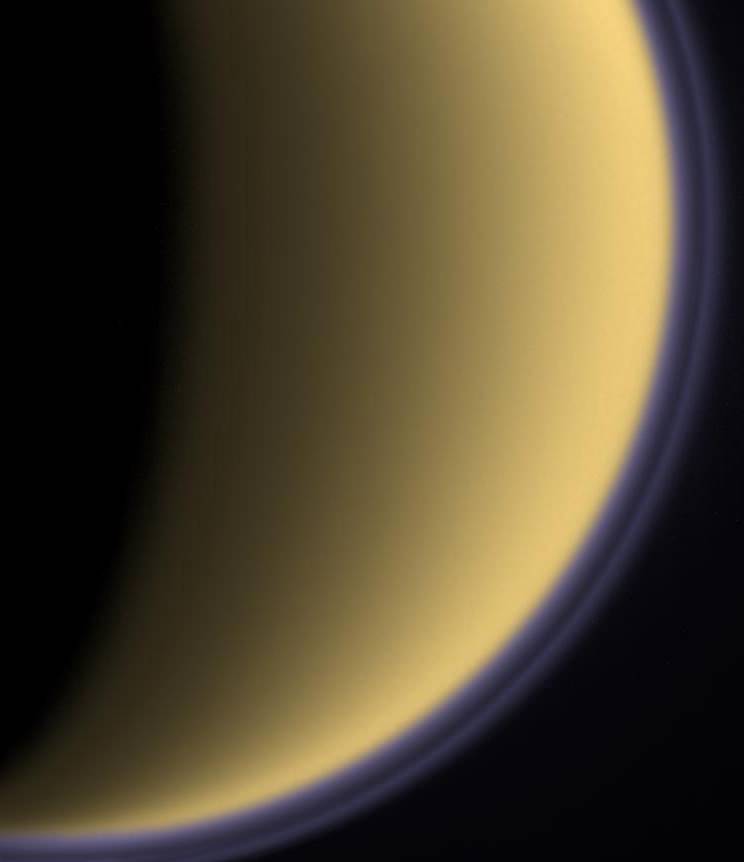

Titan's thick haze. Image: NASA/JPL/Space Science Institute.
[/caption]
Saturn’s moon Titan has long been thought to be an analog of early Earth, and a recent experiment demonstrates that amino acids and nucleotide bases — which are the basic building blocks of life on Earth – could very easily be under production in Titan’s hazy atmosphere. “Our intention was to figure out what goes on in Titan’s atmosphere using high resolution mass spectrometry,” said Sarah Horst, from the University of Arizona, a member of an international team conducting the research. “We found there could be a high number of some incredibly complex molecules being created.”
Two recent exciting discoveries led the team to try and find out more about Titan’s atmosphere: first, the discovery of high energy oxygen ions flowing into Titan’s atmosphere, and second, that there are high heavy molecular ions in the atmosphere – neither of which were expected.
“When you put two discoveries together, that leads us to possibility that oxygen can get incorporated into these large molecules and in turn, that may be incorporated into life,” Horst said in press briefing at the American Astronomical Society’s Division of Planetary Sciences meeting this week.
The intense radiation that hits the top of Titan’s thick atmosphere is capable of breaking apart even very stable molecules. The international team wanted to understand what happens as these molecules are broken apart in the atmosphere.
Working with a team in France, Horst, a graduate student, and her professor Roger Yelle, filled a reaction chamber with Titan-like atmosphere, (a cold plasma consisting of nitrogen, methane and carbon monoxide), and infused radio-frequency radiation as an energy source.
“What happens is that aerosols form in levitation — they float while forming — so this probably is very representative of Titan’s atmosphere,” Horst said. “We end up with really cool looking aerosols that have very similar sizes to aerosols that are inferred in Titan’s atmosphere.”
The molecules discovered in the aerosols include the five nucleotide bases used by life on Earth (cytosine, adenine, thymine, guanine and uracil) and the two smallest amino acids, glycine and alanine.
“The experiment showed that Titan’s atmosphere is capable of producing extremely complex molecules and has the potential for producing molecules that are important for life on Earth,” Horst said, but tempered her statement by adding, “however, this doesn’t mean there is life on Titan.”
She said if there were life on Titan, mostly likely it would use molecules that life on Earth would not use, as due to lack of liquid water, life would be completely different.
“But this tells that it is possible to make very complex molecules in the outer parts of an atmosphere,” Horst said. “We don’t need liquid water, we don’t need a surface.”
This also provides another option to how life may have started on Earth. The two main theories for how life began on Earth is that it was brought here by comets or asteroids or that it formed from a primordial soup zapped to life from lightning. But it may have formed from a primordial haze high in Earth’s atmosphere.
“This helps us to understand what processes began life on Earth and what could be happening on other exoplanets in the galaxy,” Horst said.
Source: DPS briefing
If you've ever looked at Mars through a telescope, you probably noticed its two polar…
Our Solar System is in motion and cruises at about 200 kilometres per second relative…
Late is better than never for the ‘Blaze Star’ T Coronae Borealis. It was on…
A planet's history is told in its ancient rock. Earth's oldest rocks are in the…
Data from the Chinese rover Zhurong is adding to the pile of evidence for oceans…
New information is pushing Asteroid 2024 YR4 off of our front pages. Initial estimates gave…